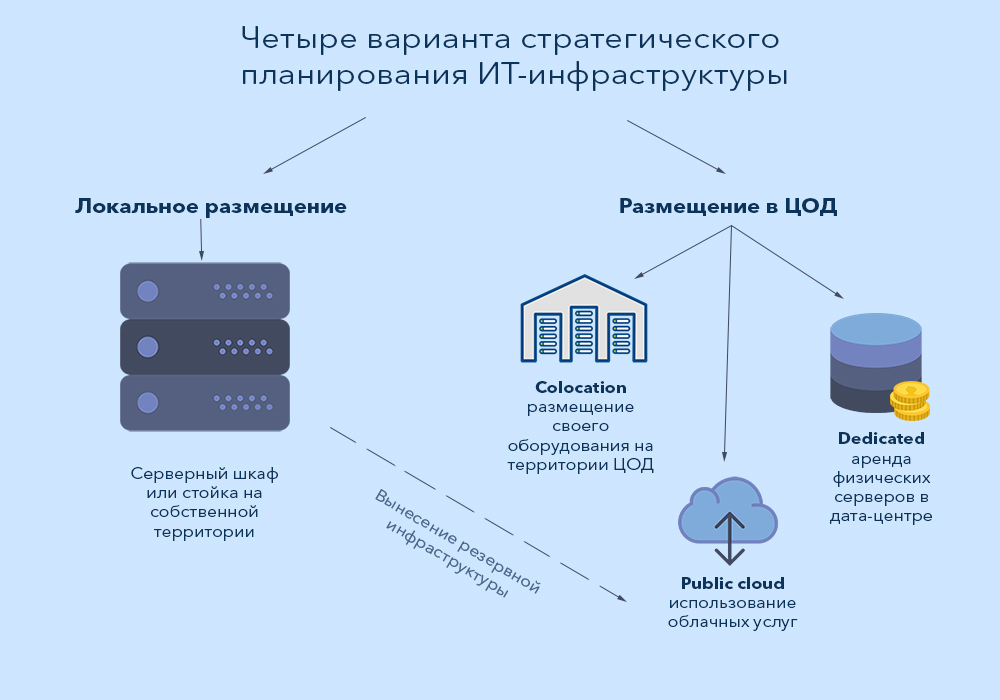Four options for strategic planning of IT infrastructure
Today there are several options for locating IT infrastructure for business. All of them have their pros and cons, about each there is enough information of varying degrees of relevance. But we did not find any generalizing material on this topic, and it became interesting for us to highlight the main scenarios of infrastructure placement and compare their advantages and disadvantages.

On the one hand, new opportunities are constantly emerging in this area, and on the other hand, business needs can both increase and decrease, goals and objectives of the IT infrastructure can change, so its future development strategy has to be analyzed and revised on a regular basis . In total, we identified four main options:
- Local placement: server cabinet or rack on its own territory;
- Colocation - placement of its equipment in the data center;
- Dedicated - rent of physical servers in the data center;
- Public cloud - the use of cloud services.
The first implies capital costs, the rest - only operational. Most often, it is advisable to place the location in a data center on the territory of the Russian Federation, but sometimes it makes sense to do it in another jurisdiction ... However, in order of all.
First option: local placement
We already had an article about local server hosting , and we can repeat the obvious facts: the main advantage of local hosting is full control over the data and ease of maintenance of the IT infrastructure with qualified specialists and competent organization of their work. You can independently deploy, configure, maintain, quickly diagnose faults and carry out repairs in the event of a breakdown. There is also no need to travel to the other end of the city or pay for the services of DC specialists if the equipment is located in another city. Full control of equipment, software and data is convenient primarily in terms of information security.

It is also worth taking into account the fact that local deployment has a positive effect on speed: local clients get a short response time when utilizing services, so if all basic services are in demand within a single office of the company, then the scenario of local server placement remains unrivaled.
However, there are also disadvantages of such a solution: the local IT infrastructure is tied to the office and, if it is relocated, it will be necessary to disconnect and transport all the equipment, and redeploy the network infrastructure. The presence of remote units and employees imposes additional requirements on the bandwidth of the Internet channel, which increases operating expenses.
Well, there always remains the risk of withdrawal of locally placed equipment by the regulatory authorities, both for real problems with them and for competitors. This risk can be reduced by placing in a separate room and renting out to another legal entity, but such a decision is not a panacea.
In addition, you will have to spend money on a full hermetic zone with sufficient cooling, backup power supply and a spare communication channel or, at a minimum, a server cabinet, which is not always comfortable to be near.

Three other options one way or another will be relevant for frequent moves from office to office, to ensure the mobility of the company, if necessary, constant access to services from remote offices or for remote employees.
The second option: colocation, placing your equipment in the data center
We have already written about the collocation, but it will not be superfluous to repeat the main theses. Thanks to the colocation, you do not have to independently engage in the reservation of communication channels and power, you do not need to think about protecting equipment from power failures, and also organize access to the Internet with sufficient bandwidth. In addition, in the case of office relocation, you will not need to transfer server infrastructure.
The problems of this scenario begin when there is a need to change the hardware configuration, as well as with any maintenance that requires "access to the body." Equipment control will also be possible only remotely. The latency of the services will depend on the parameters of access to the Internet, and of course, the foreign territory where your property and data are located is always potentially unsafe.

The third option: dedicated - server rental in the data center
The advantages in this scenario are the same as in the previous one - communication channel, power, cooling, UPS, access to the Internet, which is provided in accordance with your tariff in the data center, only the equipment will not be your property, so withdraw it raider does not work. Direct access to it will not be so simple, but it will be possible to move the whole office at least every month.
In this case, everything depends on the pricing policy of certain data centers: it often happens that those who need the equipment for up to six months are easier to rent, whereas in the case of long-term work, the total cost of rent can exceed the amount of payment for colocation and the equipment itself, especially in the case of used servers . But in general, this scenario is very similar to the previous one.
Actual offers
In order not to be unfounded, let's look at the offers of the colocation and server rental market.
Comparative data on collocation can be represented as follows:

(The Tier 3 level of the Datacheap data center with such and such prices inspires mistrust; has anyone hosted it, maybe? How much is this Tier 3?)
We consider further: to rent on 1dedic.ru a server with two E5-2630v3 3.2 GHz processors 16 cores with 16 GB of RAM and two terabyte disks will cost 20,671 rubles a month when paid for half a year. At 1gb.ru, with half a year's prepayment, you will need to pay 19.743 rubles a month to rent two Xeon E5-2670 processors 2.60 GHz / 8 processor cores each, two terabyte disks and 32 GB RAM.
At the same time, a used 6017R-NTF with two E5-2665 processors (8-cores 20M Cache, 2.40 GHz) with 16 GB of memory plus 2 1TB disks costs 101,500 rubles, together with six months of colocation payment and such a server will pay for itself in six months.
')
Fourth option: cloud storage
The main advantage of a public cloud is that if we don’t know what power we need or know for sure that capacity requirements will change unpredictably in one direction or another, it will be convenient to use such a cloud service as capacity allocation on the fly - "Elastic" or "step" allocation of power.
At certain tariff plans with a sharp increase in load (a sharp influx of visitors, the unexpected popularity of a particular service, habraeffekt) will be quickly allocated and power, and the billing system can be built so that you have to pay for computing power on the fact of their consumption. One typical example is Amazon Elastic Compute Cloud (Amazon EC2) .
Data centers domestic and foreign
Well, it’s worth considering separately the pros and cons of hosting in data centers in Russia and abroad: in recent years, the creation of foreign IT infrastructure has suddenly been seriously influenced by a political factor, and now, under the threat of new sanctions, you can simply be left without equipment and data. Placing in domestic data centers completely solves this issue, and in addition, in such a scenario, there is no cross-border traffic, which, compared with foreign deployment, reduces network latency for internal and external clients.

However, risks remain on our territory from the inspection bodies that do not exist in foreign jurisdiction (although it is worth noting that other jurisdictions can conceal other problems) - and the occurrence of troubles from the data center is more relevant in Russia. In addition, the quality of services provided abroad on average is still higher. But to use your own equipment there most likely will not work, besides, the licensed purity of the solutions used is usually very tough. Well, you should not ignore the currency risks and the need for cross-border payments, which are quite difficult to present for offsetting and reimbursement within the framework of our tax and currency legislation.
However, the cost of a leased server or private cloud abroad may be significantly lower, and the quality and level of service is significantly higher than in the Russian Federation.
findings
Summing up, we venture to assume that local deployment in most cases for small and medium businesses remains the best solution in terms of data control. Data center abroad should be used if the risks from regulatory authorities and competitors are high enough, and the domestic data center is a good compromise solution if the business has a geographically distributed network of departments.
For completeness, it is worth noting that there are combined scenarios, for example, the local deployment of the main infrastructure with the removal of the backup infrastructure to the public cloud. With proper backup organization, it allows you to quickly restore work even in the event of a complete and irretrievable failure of the main equipment.
And what decision did you choose for yourself? What pitfalls met?
Source: https://habr.com/ru/post/319878/
All Articles